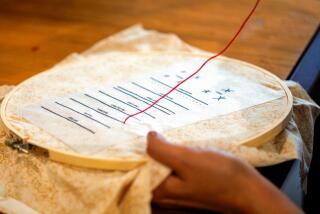Love of Sewing Has Given Her a Pattern in Life
- Share via
COSTA MESA — Maria Zelaya said she didn’t choose her career--it chose her.
Zelaya sews samples for sportswear manufacturer Quiksilver Inc. in Costa Mesa. Zelaya, like other women from low-income families in her native Managua, Nicaragua, became a costurera , or seamstress, because tuition for a sewing trade school was more affordable than other vocational schools. But what began as a job, has become a passion.
“There’s nothing I don’t like (about) my job,” Zelaya said in Spanish. “It’s like I’m at home. There’s a lot of camaraderie with my co-workers.”
Zelaya, 37, said she counts the 11 other sewers and one fabric cutter she works with among her best friends.
Their work is unlike that of piece-work sewers, who can spend weeks on end sewing the same type of button hole into thousands of garments. Rather, sample sewers work with designers and pattern makers stitching together entire garments.
“I have to sew everything,” Zelaya said. “Regardless of the material or design, I do it all.”
The Tustin resident’s sewing ability comes from more than 20 years of experience. Zelaya is married and the mother of two teen-agers, Juan Carlos and Martha, and 3-year-old Sylvia. Fleeing the volatile political situation in her homeland, Zelaya and her family came to California in 1981. Since then, Zelaya has worked for several different sportswear manufacturers.
“I came with a lot of experience,” Zelaya said. “I knew how to sew and also how to keep production lines running smoothly.”
In fact, Zelaya so impressed her former bosses at Catalina sportswear in Los Angeles, that they made her a supervisor just two weeks after hiring her as a seamstress. Zelaya continued working at the company for seven years.
Later, Zelaya worked for another local sportswear company, Cole of California. But, when the company was bought out in 1989, the new owners changed things. Different types of sewing machines were brought in and the sewers were forced to adapt.
“A lot of tensions built up,” Zelaya said. “People were unhappy and complained a lot.”
About six months after the new owners took over, Zelaya quit. She went to work as a sample maker for Raj Manufacturing Inc. in Tustin. She sewed bathing suits for the small company for two years before answering an employment ad that led to her being hired at Quiksilver. She said she liked the company immediately.
“It’s very big and there is more job security,” Zelaya said. “They saw my experience and gave me my position.”
Zelaya has also learned new skills during the four years she’s worked at Quiksilver. Zelaya said she likes to learn and that working on a computer filing job orders has become part of her job as a result.
But there is still one thing holding her back. Zelaya acknowledges that her limited English skills are a source of frustration.
“I understand a lot,” Zelaya said. “But it’s tough for me to speak.”
That’s why she has enrolled in a three-unit English class at Orange Coast College in Costa Mesa.
(BEGIN TEXT OF INFOBOX / INFOGRAPHIC)
OCCUPATION: Sewing machine operator
* What’s involved: Working with designers and pattern makers to put together new clothing items.
* Qualifications: Knowledge of production operation, including courses on how to operate specialty sewing machines, is important to becoming a sewing machine operator.
* Outlook: By 1998, the number of garment industry sewing machine operators in the county is expected increase by 10% to 3,990.
* Salary range: $8-$10 per hour, depending on experience.
* Pros: Most operators who make samples enjoy handling projects from start to finish.
* Cons: Because operators are often paid by piece, they must do their jobs very quickly.
* Advancement: Operators may eventually work as factory supervisors or managers.
* Quote: “There’s a chance to learn. And it’s like working in your living room when you like your co-workers.”--Maria Zelaya
Researched by VALERIE WILLIAMS-SANCHEZ / Los Angeles Times






